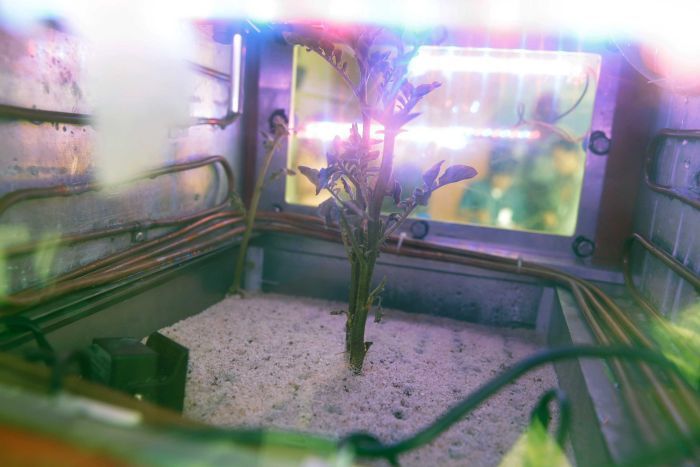Peruvian scientists grow potato in Mars-like conditions, in quest for extraterrestrial agriculture
Posted
In a lab in the Peruvian capital of Lima, a simulator mimicking the harsh conditions found on Mars now contains a hint of life: a nascent potato plant.
Key points:
- Results indicate potatoes may one day grow on Mars
- Scientists built Mars simulator with below-zero temperatures, high carbon monoxide concentrations and low air pressure
- Findings could also benefit crop growth in arid areas
After experimenting in the Andean nation's dry, desert soil, scientists have successfully grown a potato in frigid, high carbon-dioxide surroundings.
Though still in early stages, investigators at the International Potato Centre believe the initial results are a promising indicator that potatoes might one day be harvested under conditions as hostile as those on Mars.
The findings could benefit not only future Mars exploration, but also arid regions already feeling the impact of climate change.
"It's not only about bringing potatoes to Mars, but also finding a potato that can resist non-cultivable areas on Earth," said Julio Valdivia, an astrobiologist with Peru's University of Engineering and Technology who is working with NASA on the project.
The experiment began in 2016 — a year after the Hollywood film The Martian showed a stranded astronaut surviving by figuring out how to grow potatoes on the red planet.
Scientists built 'Mars-in-a-box'
Peruvian scientists built a simulator akin to a Mars-in-a-box: Frosty below-zero temperatures, high carbon monoxide concentrations, the air pressure found at 6,000 metres altitude and a system of lights imitating the Martian day and night.
Though thousands of miles away from colleagues at NASA's Ames Research Centre in California providing designs and advice, Peru was in many ways an apt location to experiment with growing potatoes on Mars.
The birthplace of the domesticated potato lies high in the Andes near Lake Titicaca, where it was first grown about 7,000 years ago.
More than 4,000 varieties are grown in Peru, Bolivia and Ecuador, where potatoes have sprouted even in cold, barren lands.
The Peruvian scientists did not have to go far to find high-salinity soil similar to that found on Mars, though with some of the organic material Mars lacks: Pampas de la Joya along the country's southern coast receives less than a millimetre of rain a year, making its terrain somewhat comparable to the Red Planet's parched ground.
International Potato Center researchers transported 700 kilos of the soil to Lima, planted 65 varieties and waited. In the end, just four sprouted from the soil.
Live-streaming cameras caught every tiny movement as a bud sprouted and grew several leaves while sensors provided around-the-clock monitoring of simulator conditions.
The winning potato was a variety called Unique.
"It's a 'super potato' that resists very high carbon dioxide conditions and temperatures that get to freezing," Dr Valdivia said.
Ray Wheeler, the lead for advanced life support research activities at NASA's Kennedy Space Centre, said plant survival in the open on Mars would be impossible given the planet's low-pressure, cold temperature and lack of oxygen, but showing plants could survive in a greenhouse-type environment with reduced pressure and high carbon-dioxide levels could potentially reduce operating costs.
Most research on growing plants in space has focused on optimising environments to get high output of oxygen and food.
"But understanding the lower limits of survival is also important, especially if you consider pre-deploying some sort of plant growth systems before humans arrive," Dr Wheeler said.
In the next stage of the experiment, scientists will build three more simulators to grow potato plants under extreme conditions with the hope of gaining a broader range of results.
They will also need to increase the carbon dioxide concentrations to more closely imitate the Martian atmosphere.
AP
Topics: science-and-technology, astronomy-space, space-exploration, agricultural-crops, peru








